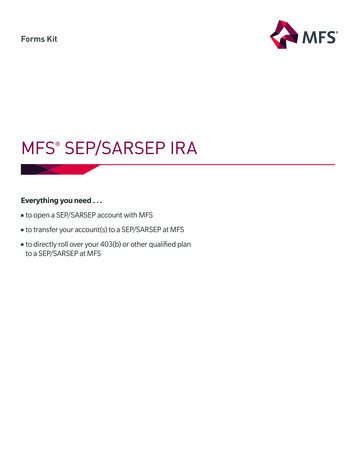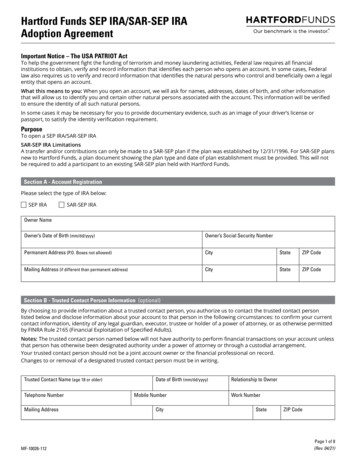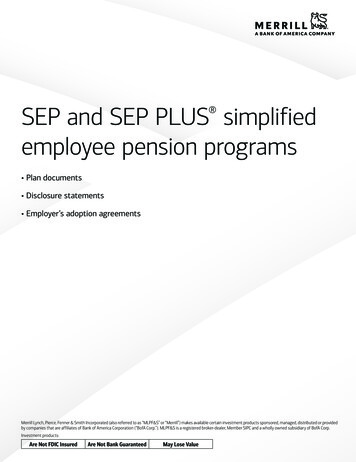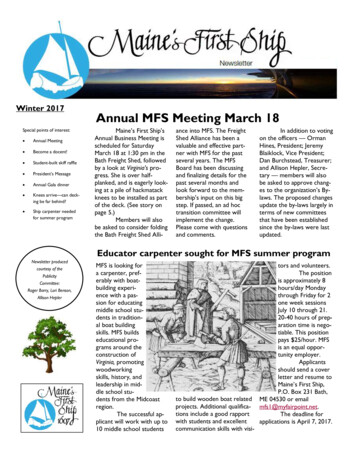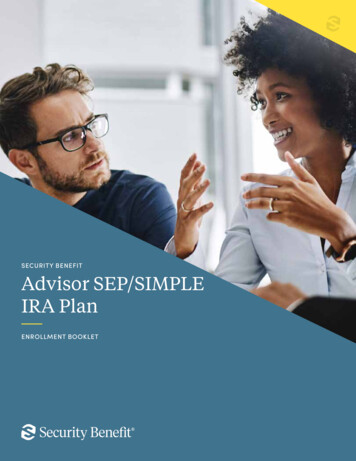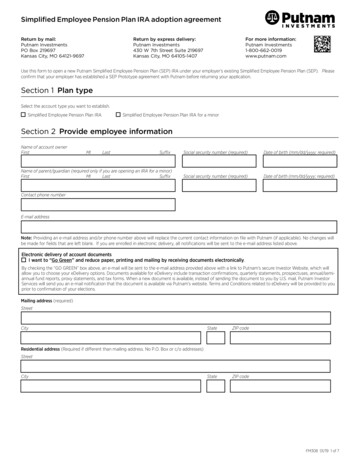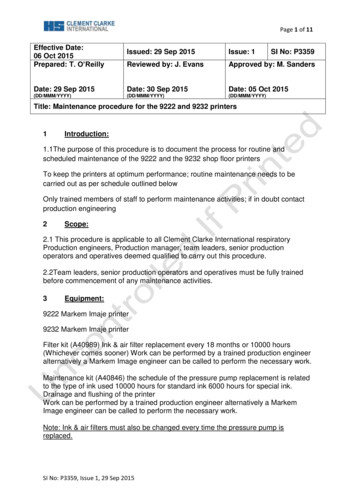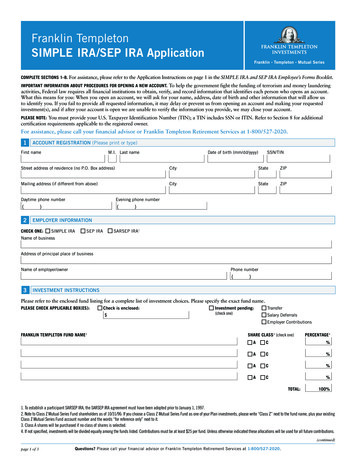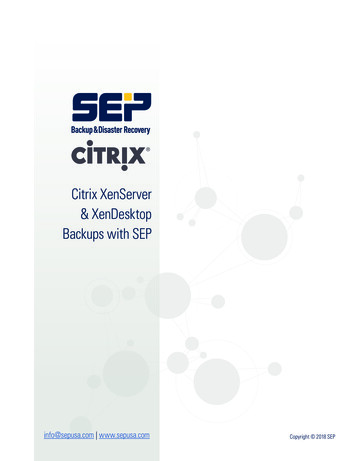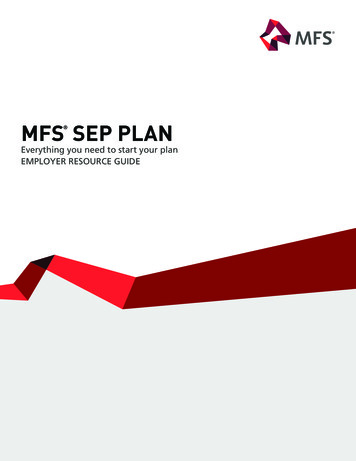
Transcription
MFS SEP PLAN Everything you need to start your planEMPLOYER RESOURCE GUIDE
EMPLOYER INSTRUCTIONSFor completion of MFS SEP forms. Documents are numbered for your convenience.MFS SEP1. Read all documents, especially the Plan Document (#5) and Information About the Plan (#4). Keep them for your files.2. Complete the SEP Adoption Agreement (#1).3. Complete the SEP Plan Employee Summary (#2).4. Distribute to each employee: SEP Plan Employee Summary (#2) SEP Employee Kit, containing– SEP Questions and Answers– IRA Forms Kit (Each participant should complete the MFS IRA Application. If this is a transfer of assets, theparticipant should also complete the MFS IRA Transfer Form.)5. Send a copy of the SEP Adoption Agreement, the original MFS SEP Application and Transfer Form (if applicable) foreach participant and your investment check to:Complete and mail all appropriate forms to:Regular mailMFS Service Center, Inc.P.O. Box 219341Kansas City, MO 64121-9341Overnight mailMFS Service Center, Inc.Suite 219341430 W 7th StreetKansas City, MO 64105-1407 IRAs cannot be established without signed IRA applications. Make checks payable to MFS Heritage Trust Company.IMPORTANT NOTE: The SEP Top-Heavy Worksheet (#3) is kept by the Employer orthe Plan Administrator — This worksheet is used to determine if the plan is top heavy.Article 6 of the enclosed Plan Document describes the corrective action that must betaken if the top-heavy percentage exceeds 60%.
FORM #1SEP ADOPTION AGREEMENTFOR MFS PROTOTYPE SEP PLANSThis Adoption Agreement is part of the MFS Prototype Simpli fied Employee Pension Plan. You must complete this AdoptionAgreement properly to establish a SEP Plan.1. EMPLOYER INFORMATIONADOPTING EMPLOYERADDRESSCITYSTATEFEDERAL TAX ID NUMBERZIP CODEDAYTIME PHONE NUMBERTAXABLE YEAR-END (MM/DD)2. GENERAL PLAN PROVISIONSA. Plan Year. If the Employer’s taxable year is the calendar year, the plan year will be the calendar year. If the Employer’staxable year is not the calendar year, the Employer elects that the plan year be (choose one):(i)Calendar year(ii)The Employer’s taxable year beginningand endingB. Effective Date. Check and complete either (i) or (ii), whichever is applicable.(i)This is a new SEP plan; the Employer does not currently maintain a SEP. The effective date of this Plan isDATE (MM/DD/YYYY)(ii)This is an amendment and restatement of the Employer’s existing SEP plan.(a) The original effective date of the Plan isDATE (MM/DD/YYYY)(b) The effective date of this amendment and restatement isDATE (MM/DD/YYYY)The Employer may elect that the effective date in (i) and (ii)(b) above be the first day of the plan year in which thisAdop tion Agreement is signed or any later date.page 1 of 3
FORM #13. EMPLOYEE ELIGIBILITYThe Employer may (but need not) exclude one or more of the following categories of employees from participationin the Plan. Check each kind of employee you wish to exclude. Items (iv) and (v) must also be completed if checked.The Employer elects to exclude from participation in the Plan:(i)Employees who have not received at least 550 of compensation from the Employer during the plan year(ii)E mployees who are covered by a collective bargaining agreement, if retirement benefits were the subject ofgood faith bargaining(iii)E mployees who are nonresident aliens and who receive no earned income from the Employer that constitutesearned income from sources within the United States(iv)Employees who have not attained age(v)E mployees who have not performed services for the Employer during at leastthree) of the immediately preced ing five plan years.(not more than 21).(not more thanThese exclusions are described in greater detail in Section 3.1 of the Plan.4. CONTRIBUTIONSA. Compensation. Check here only if the Employer does not wish to include in the definition of compensation amounts the Employercontributes on behalf of employees pursuant to a salary deferral form not includible in the employees’ income underCode Sections 125, 402(a)(8), 402(h) or 403(b).B. Allocation of Employer Discretionary Con tributions. You must choose one of the following methods foral locating to the SEP IRA of each participating employee the discretionary employer contribution (if any) you makefor each plan year. If you choose method (iii), you must also complete the “integration level” informa tion. Each ofthese allocation formulas is described in greater detail in the plan document.The Employer elects to allocate discretionary employer con tri bu tions according to the:(i)F lat Dollar Formula: described in Plan Sec tion 5.2(a); under this formula the same dollar amount will be allocatedto each participant’s IRA.(ii)P ro Rata Discretionary Formula: descri bed in Plan Section 5.2(b); under this for mula Employ er con tribu tions willbe allocated to each participant’s IRA as the same percentage of each participant’s compensation.(iii)I ntegrated Discretionary Formula: de scribed in Plan Section 5.2(c); under this for mula par ti ci pants whose compensation exceeds the integr ation level will be allocated a higher per centage of the Employer’s contribu tion thanparticipants whose compensation is below the integr ation level.The integration level will be (choose one and complete if you choose (b)):(a) the taxable wage base(b)Page 2 of 3% of the taxable wage base
FORM #15. TOP-HEAVY RULESComplete this section only if you maintain one or more other retirement plans in addition to this Plan and you wish touse a plan other than this Plan to satisfy the top-heavy requirements (to the extent applicable).The Employer designates the following plan to satisfy the top-heavy requirements of Code Section 416:6. EMPLOYER SIGNATUREEMPLOYERBYDATEpage 3 of 3
FORM #2SEP PLAN EMPLOYEE SUMMARYFor MFS Prototype Simplified Employee Pension PlanThis is a brief summary describing provisions of your Employer’s SEP Plan. This summary relates only to provisions thatare specific to your Employer’s plan. You should read your SEP Questions and Answers booklet for more extensiveinformation about the Plan.1. PLAN YEARThe taxable year of the Plan (“plan year”) is:the calendar yearyour Employer’s taxable year (if other than a calendar year)2. ELIGIBILITY TO PARTICIPATEYour Employer has elected not to allow the following employees to participate in the plan:employees who have not received at least 550 of compensation during the plan yearemployees who are covered by a collective bargaining agreementemployees who are nonresident aliensemployees who have not attained age(not more than 21) employees who have not performed services for the Employer during at leastof the immediately preceding five plan years(not more than three)3. CONTRIBUTIONS PERMITTEDDiscretionary employer contributions only: Your Employer may (but it is not required to) make discretionary employercontributions to your SEP IRA.4. ALLOCATION OF DISCRETIONARY EMPLOYER CON TRI BUTIONSYour Employer has chosen to allocate the discretionary employer contributions (if any) it makes for any plan yearaccording to the following formula:Flat Dollar Formula: The same dollar amount will be allocated to each participant’s IRA. Pro Rata Discretionary Formula: Employer contributions will be allocated to each participant’s IRA as the samepercentage of each participant’s compensation. Integrated Discretionary Formula: Participants whose compensation exceeds the “integration level” will beallocated a higher percentage of the Employer’s contributions than participants whose compensation is belowthe integration level.The integration level will be(a) the taxable wage base(b)% of the taxable wage baseThe integrated discretionary allocation formula is described in detail in Part 2 of the SEP Questions and Answers booklet.5. FOR MORE INFORMATIONIf you would like more information or have any questions about your Employer’s SEP Plan, contactpage 1 of 1
FORM #3SEP TOP HEAVY WORKSHEETFor MFS Prototype Simplified Employee Pension PlanIf the employer maintains another SEP plan or qualified retirement plan, this worksheet is not appropriate.The employer must test the SEP Plan annually at the end of the plan year to determine whether the plan is top heavyfor the plan to comply with Code Section 408(k)(1). If the plan is top heavy for any plan year, the employer may berequired to make a minimum contribution on behalf of each employee who is not a key employee (a “non-key employee”).Article 6 of the SEP Plan document contains an explanation of the top-heavy rules. If your plan is top heavy and youneed further guidance, you should consult your own advisor.InstructionsIndicate if the SEP plan was found to be top heavy as of the determination date (the last day of the plan year) immediatelypreceding the date of adoption of the MFS Prototype SEP Plan.YesNoTo begin:Step 1: Identify each of your employees who is a key employee. To determine who is a key employee, see Article 6of the SEP Plan, Code Section 416(i) and applicable regulations.THE WORKSHEETCOLUMN ACOLUMN BCOLUMN CCOLUMN DKey EmployeesKey EmployeesAccount BalancesNon-key EmployeesNon-key EmployeesAccount BalancesTOTAL BTOTAL DALL TOTALITEM E: %TOTAL BALL TOTALTOP-HEAVY PERCENTAGEpage 1 of 2
FORM #3STEP 2: List each employee or former employee who is a key employee in column A. An individual who was nota key employee or was not employed by the employer at any time during the plan year preceding the planyear for which the test is being conducted (or the last day of the plan year, if this is the first plan year ofthe plan) should not be included as a key employee.STEP 3: In column B, list the total contributions made by the employer to the key employee’s SEP IRA from the keyemployee’s initial participation in the plan through the last day of the previous plan year (or the last day ofthe plan year, if this is the first plan year of the plan).STEP 4: List each employee or former employee who is not a key employee in column C. An individual who has notbeen employed by the employer at any time during the plan year preceding the plan year for which thetest is being conducted (or the last day of the plan year, if this is the first plan year of the plan) should notbe included as a non-key employee.STEP 5: In column D, list the total contributions made by the employer to the non-key employee’s SEP IRA from thenon-key employee’s initial participation in the plan through the last day of the previous plan year (or thelast day of the plan year, if this is the first plan year of the plan).STEP 6: Add all of the contribution amounts listed in column B for key employees and enter the total in theTOTAL B box at the bottom of column B.STEP 7: Add all of the contribution amounts listed in column D for non-key employees and enter the total in theTOTAL D box at the bottom of column D.STEP 8: Add the amount in the TOTAL B box to the amount in the TOTAL D box and enter the sum in the ALLTOTAL box.STEP 9: In Item E, determine the percentage that the total contributions of all key employees is of the total contributions of all employees (TOTAL B divided by ALL TOTAL). Enter the percentage in Item E. This is the top-heavypercentage.STEP 10: If the top heavy percentage is less than or equal to 60%, the plan is not top heavy. If the top-heavypercentage is greater than 60%, the plan is top heavy; see Article 6 of the SEP Plan.Page 2 of 2
FORM #4INFORMATION ABOUT THE PLANFor MFS Prototype SEP Plans1. What it isA SEP plan is a retirement plan. Under the plan, the employer may (but is not required to) make employer contributionsthat will be paid into each employee’s SEP IRA.2. Who may adopt a prototype SEPAlmost any kind of employer may adopt a SEP plan, whether it is a corporation, a partnership, a proprietorship, oranother form of business entity. However, if the employer at any time has maintained a defined benefit pension planthat has been terminated, the employer can only adopt an individually designed SEP plan, not a prototype plan.3. Who is the employerIf your business is conducted through a partnership or proprietorship, the partnership or proprietorship is the employer.Self-employed persons are employees of that employer for purposes of the plan, so they may receive contributions.If the business entity that maintains the plan is a member of a controlled group of businesses, as defined in Section414(b) or (c) of the Internal Revenue Code (“Code”), is a member of an affiliated service group, as defined in CodeSection 414(m), or is otherwise required to be aggregated with other entities under Code Section 414(o), then the planmust cover all employees of all entities in the group. If the employer has any “leased employees,” as defined in CodeSection 414(n), the plan also must cover those leased employees, to the extent required by law.4. Amount of contributionsThe maximum amount an employer can contribute to any employee’s SEP IRA for 2013 is the lesser of 51,000 or 25%of the employee’s compensation. Compensation for this purpose is limited to 255,000 (for 2013, as adjusted for costof living increases).5. Basic Plan Features(a) IRS Filings. Generally, with a SEP you need not make the following filings on the plan with the IRS.(i)IRS Opinion Letter: This MFS SEP plan has received a favorable IRS Opinion Letter. MFS’ IRS Opinion Letter maybe relied upon by the Employer, and you need not file for an IRS ruling on your plan.(ii)Form 5500: As long as the employer provides its employees with the employee materials contained in this MFSSEP package, it need not file an annual return with the IRS on Form 5500.(b) Employer Tax Deduction. All contributions pursuant to the SEP Plan are deductible by the employer for federalincome tax purposes, up to the statutory limit on the amount of SEP contributions.(c) Establishment. Even if the employer’s taxable year has ended, the employer may adopt this plan and make contributions for that year as long as the employer adopts the plan (and then makes contributions) by the due date forfiling the employer’s federal income tax return for that year. If the employer currently maintains a SEP plan, it mayadopt this MFS SEP Plan as an amendment and restatement at any time, effective as of the first day of the planyear in which the adoption occurs (or any later date).(d) Employee Eligibility. There are certain kinds of employees the employer is permitted by law to exclude fromparticipation in the plan. The employer will choose which of those kinds of employees it actually will excludeon the adoption agreement.(e) Allocation of Employer Contributions. The law restricts the way an employer can allocate contributions amongemployees’ IRAs to prevent unfair discrimination. Under the MFS SEP Plan, employer contributions may be allocatedto employees’ SEP IRAs in one of three ways:(i)each employee could receive the same dollar amount;(ii)each employee could receive the same percentage of his or her compensation (for example, each employeecould receive an amount equal to 5% of his or her compensation); orpage 1 of 2
FORM #4(iii) the amount each employee receives could vary because the allocation formula takes into account the SocialSecurity taxes the employer pays; this results in employees with higher compensation receiving a contributionthat is a greater percentage of their compensation than employees with lower compensation.The employer will choose which method of allocating employer contributions it will actually use on the adoption agreement.6. Top-heavy requirementsIf the plan is “top heavy,” the employer may be required to make a minimum employer contribution for each employeewho is not a “key employee.” The term “key employee” is defined by law; the definition is also stated in Article 6 of theplan. Very briefly, a plan is top heavy for a year if the value of the accounts of key employees attributable to employercontributions is more than 60% of the value of the accounts of all employees attributable to employer contributions.The employer must determine each year whether the plan is top heavy for that year.This SEP Plan package contains a worksheet to assist the employer in performing the top-heavy test.Page 2 of 2
FORM #5SEP PLAN DOCUMENTFor MFS Prototype SEP PlansArticle 1 — Establishing the plan1.1Qualification of Plan. This Plan is an MFS prototype simplified employee pension plan (“SEP’) within themeaning of Code Section 408(k) that was approved as to form by the Internal Revenue Service (“IRS”) inOpinion Letter Serial Number K402204b dated April 16, 2003.The Employer intends to operate this Plan in accordance with its terms and with applicable provisions of theCode and ERISA. The Employer also intends to operate the Plan for the exclusive benefit of its Employeesand their beneficiaries.1.2Eligible Employers. An Employer that has ever maintained a defined benefit plan that has now terminated isnot eligible to adopt this prototype SEP plan. However, an Employer that either maintained a defined benefitplan that has now terminated or terminates any defined benefit plan subsequent to adopting this Plan might beable to maintain a SEP plan as an individually designed plan.1.3IRA Necessary. Each Employee who participates in this prototype SEP plan must establish and maintain an IRA(as defined in Section 2.9). Since this SEP plan must be used with an IRA, if any Participant fails to establish anIRA, the Employer may establish an IRA on the Participant’s behalf for the purpose of paying contributions allocable to the Participant under this Plan.1.4Employers in Controlled Group. Each individual who is an Employee of any employer that is included in thesame controlled group of employers with the Employer under Code Section 414(b), (c), (m) or (o) and who iseligible to participate in the Plan under Article 3 must be a Participant in order for the Plan to qualify as a SEPplan within the meaning of Code Section 408(k).Article 2 — Definitions2.1Adoption Agreement means the agreement signed by the Employer by which the Employer adopts this SEPplan, which agreement is incorporated herein and made a part hereof.2.2Code means the Internal Revenue Code of 1986, as amended, and regulations thereunder.2.3Compensation means the amount of an Employee’s compensation, as determined below, that is actually paidor made available to the Employee during the Plan Year:(a) 450 Limit (indexed annually). For purposes of determining whether an Employee has received compensation of at least 450 (for the 2002 calendar year, as indexed thereafter) within the meaning of Code Section408(k)(2)(C), “Compensation” shall mean the Employee’s compensation, as defined in Code Section 414(q)(4), from the Employer.(b)Other Purposes. Subject to subsections 2.3(c) through 2.3(e), for all other purposes, a Participant’s“Compensation” shall mean the Participant’s wages, as defined in Code Section 3401(a) for purposesof income tax withholding at the source, from the Employer but determined without regard to any rulesthat limit the remuneration included in wages based on the nature or location of the employment or theservices performed (such as the exception for agricultural labor in Code Section 3401(a)(2)).(c)Self-Employed Persons. For any self-employed individual who is a Participant, “Compensation” shallmean the Participant’s Earned Income.(d)Salary Reduction Amounts. Unless the Employer otherwise elects in the Adoption Agreement,“Compensation” shall also include any amount the Employer contributes on behalf of a Participantpursuant to a salary reduction agreement that is not includible in the Participant’s gross income underCode Sections 125, 402(e)(3), 402(h) or 403(b), except that, for purposes of applying the 25% ofCompensation limit described in Section 4.1, “Compensation” shall not include any SEP plan contributions.page 1 of 8
FORM #5(e) 200,000 Limit. In addition to other applicable limitations set forth in the Plan, and notwithstandingany
Complete the SEP Adoption Agreement (#1). 3. Complete the SEP Plan Employee Summary (#2). 4. Distribute to each employee: SEP Plan Employee Summary (#2) SEP Employee Kit, containing – SEP Questions and. Answers – IRA Forms Kit (Each participant should complete the
